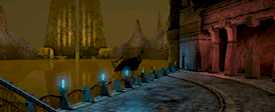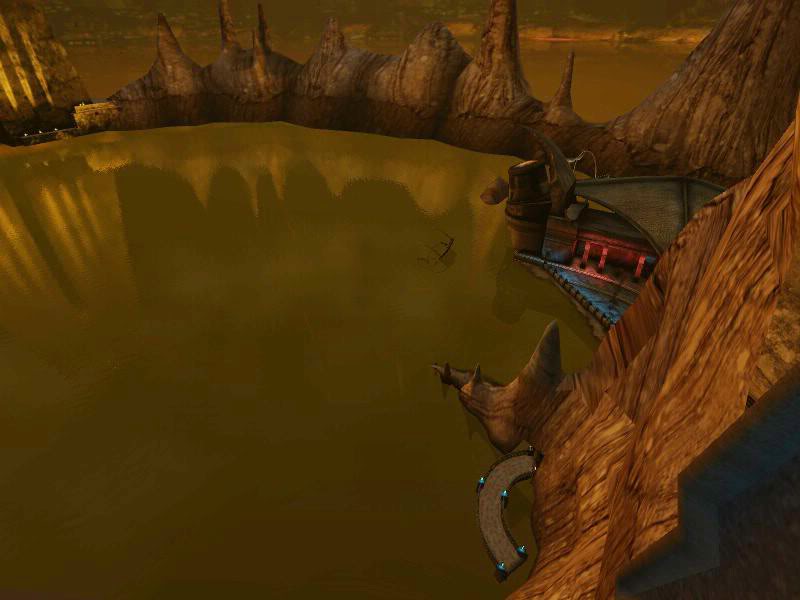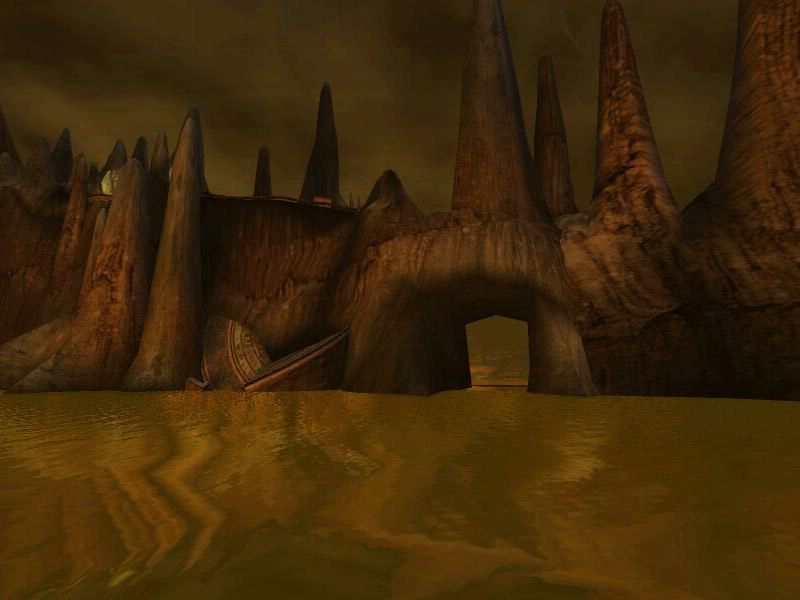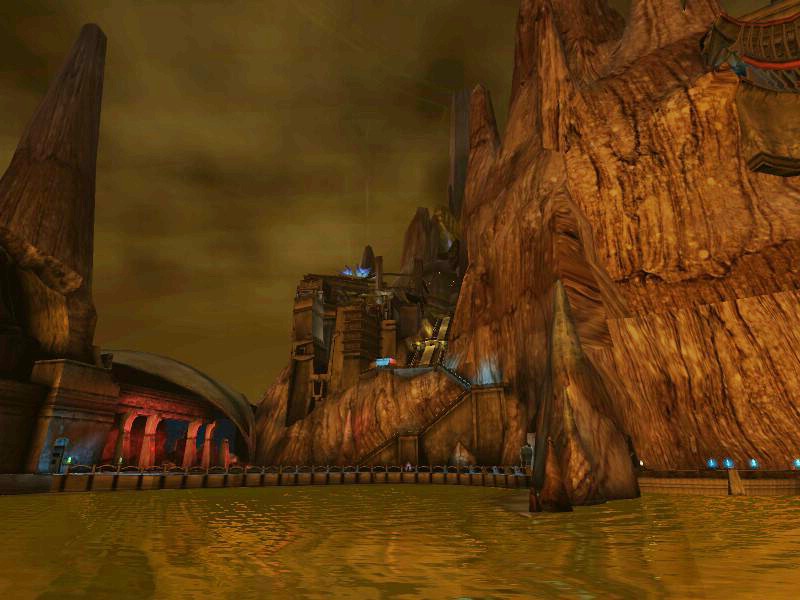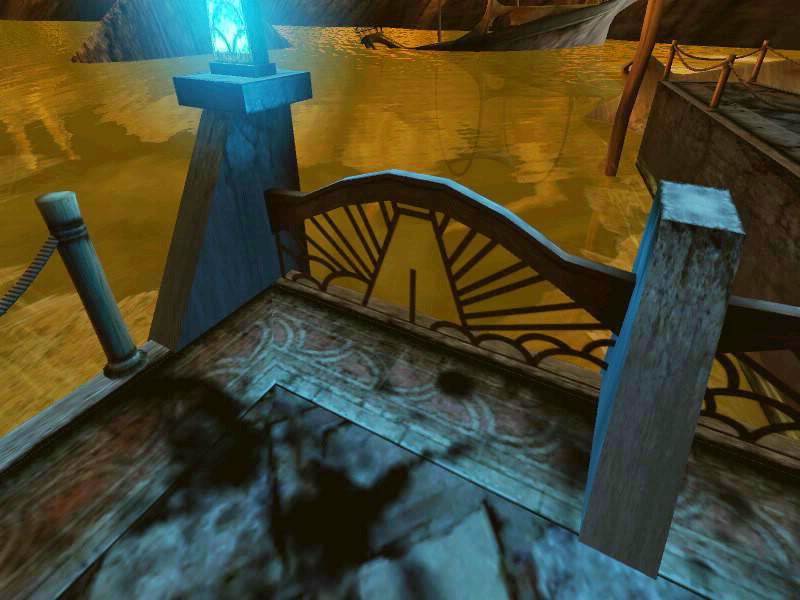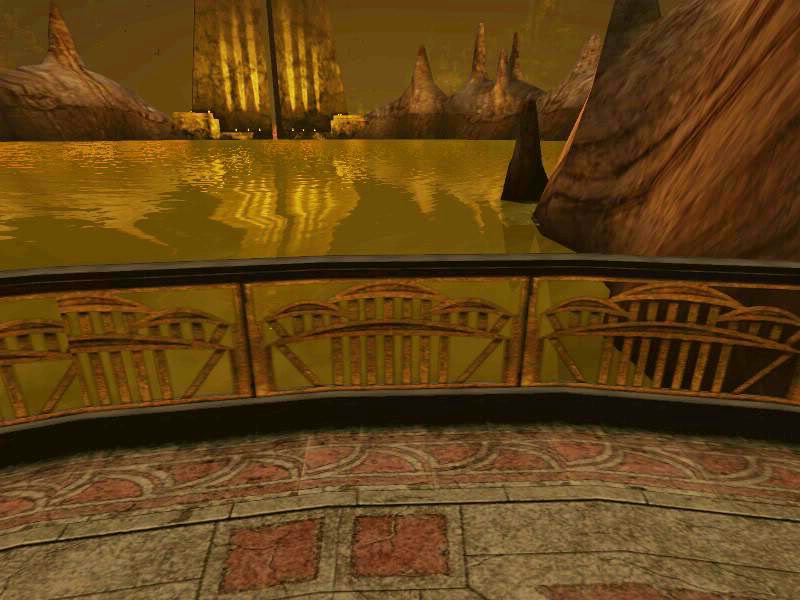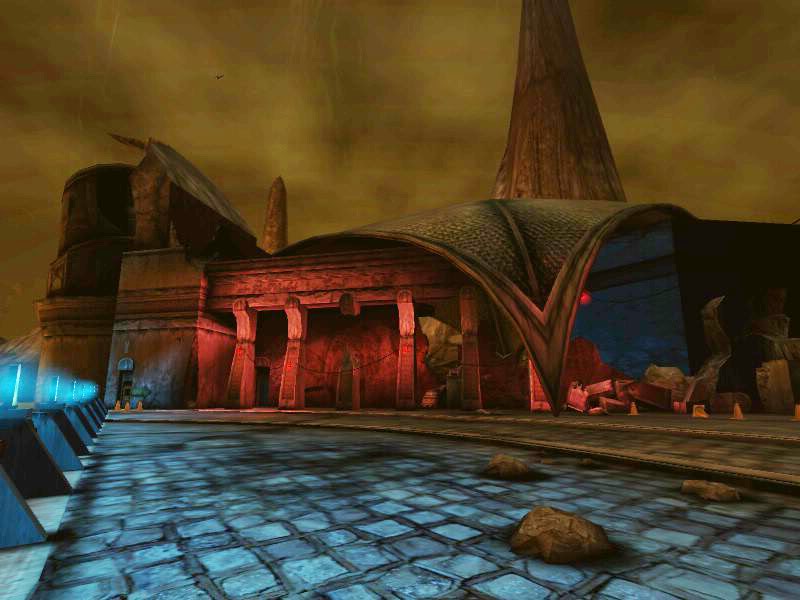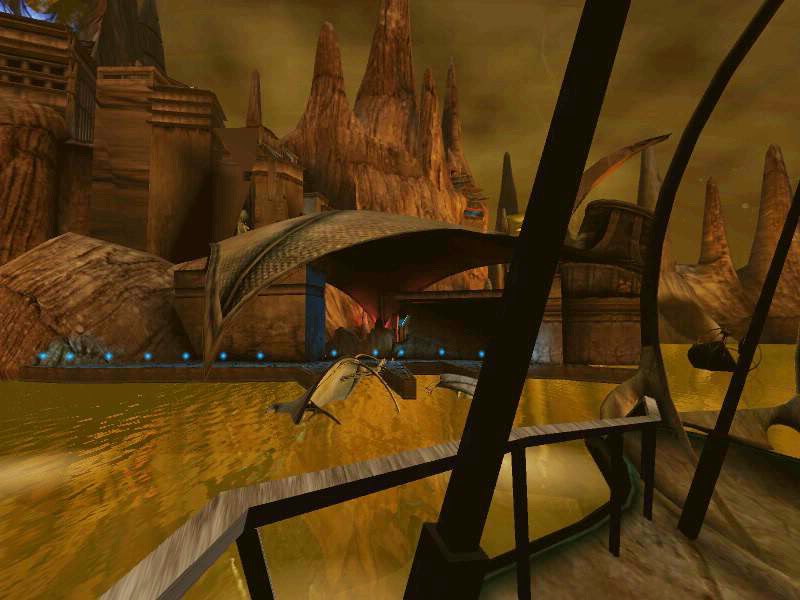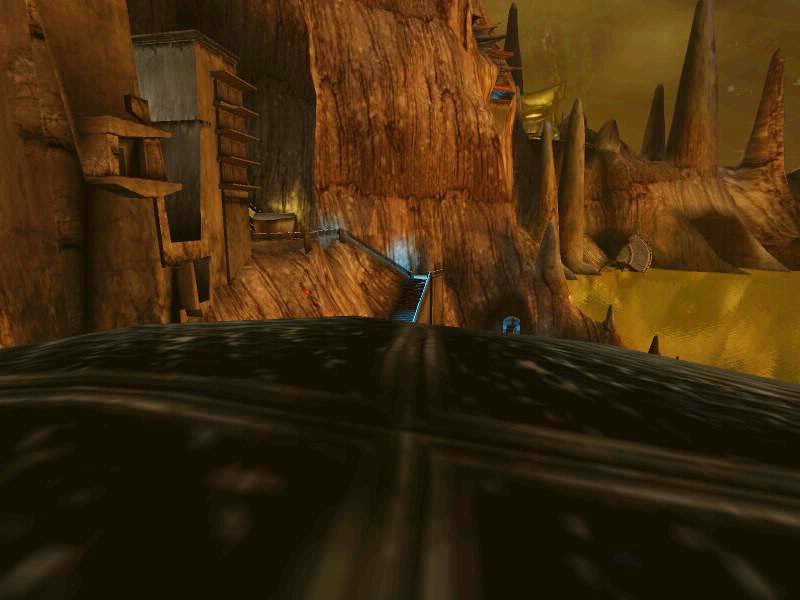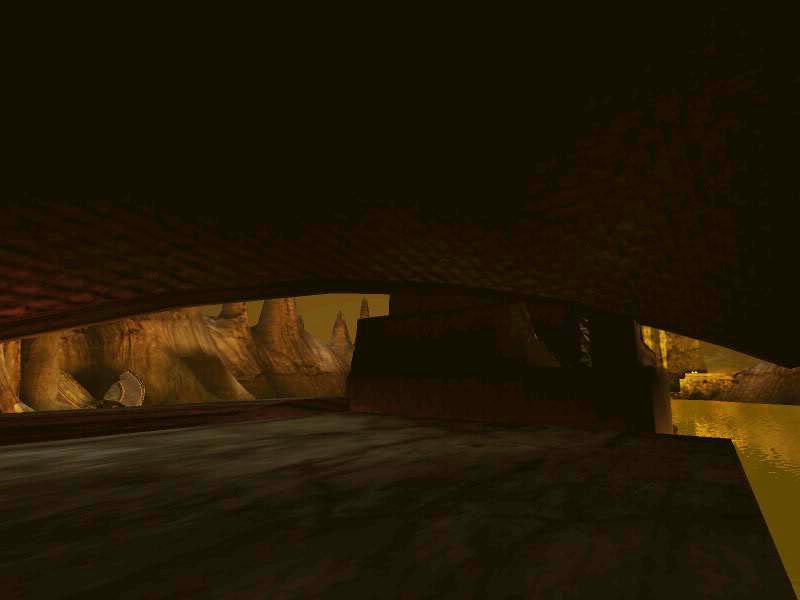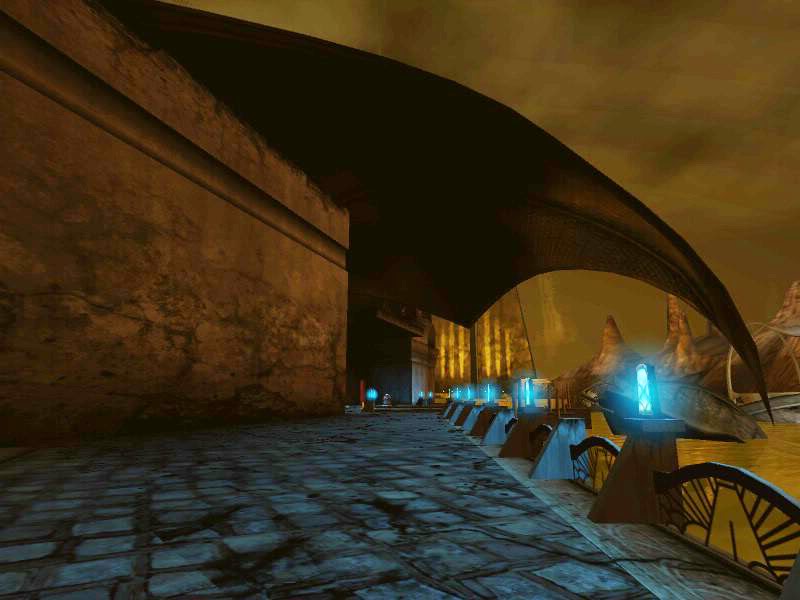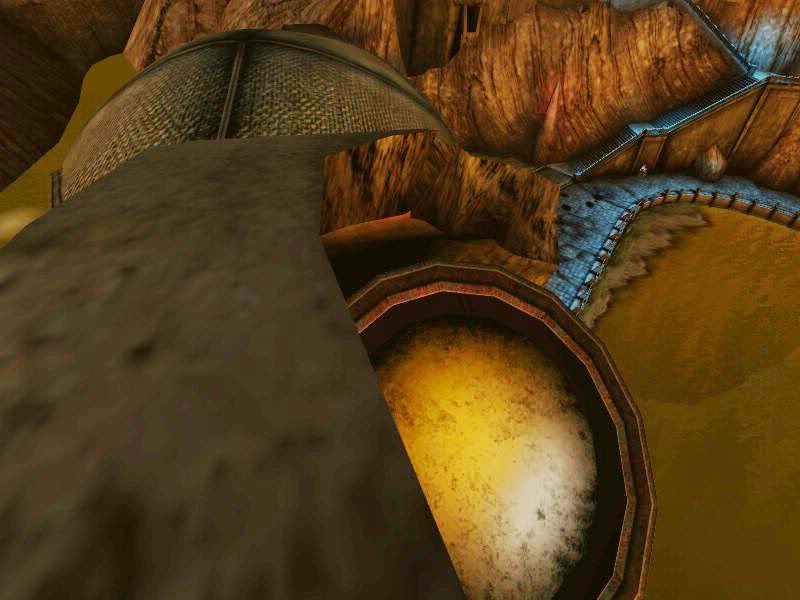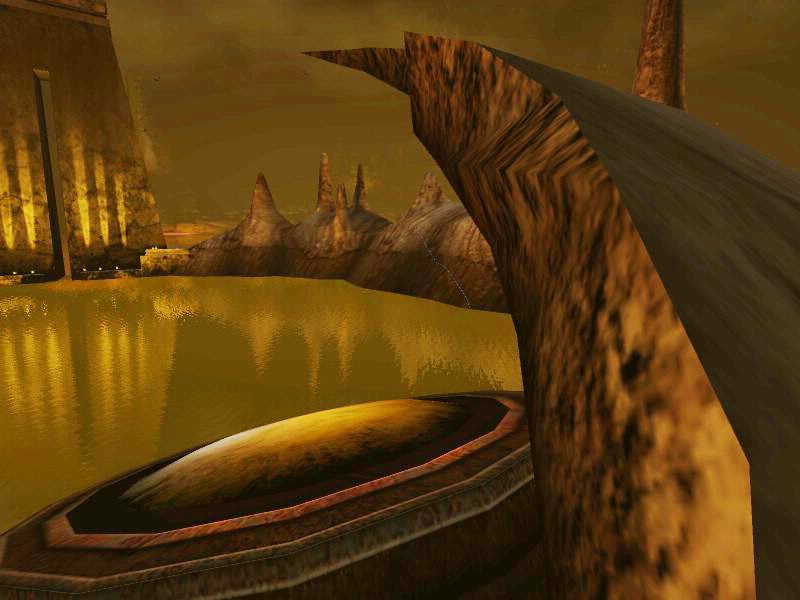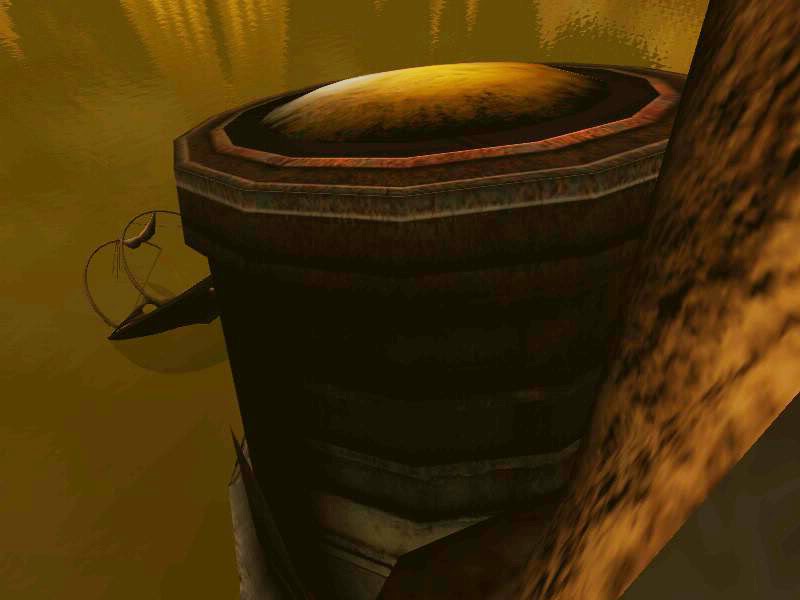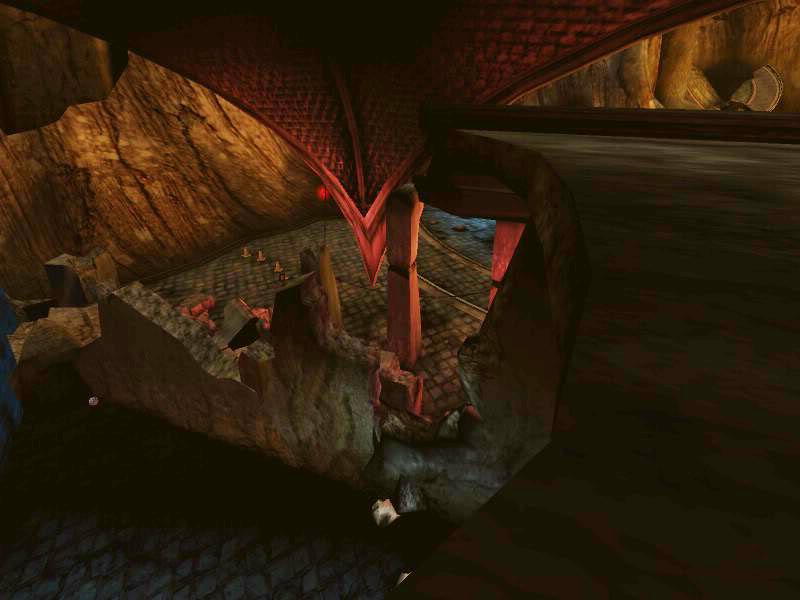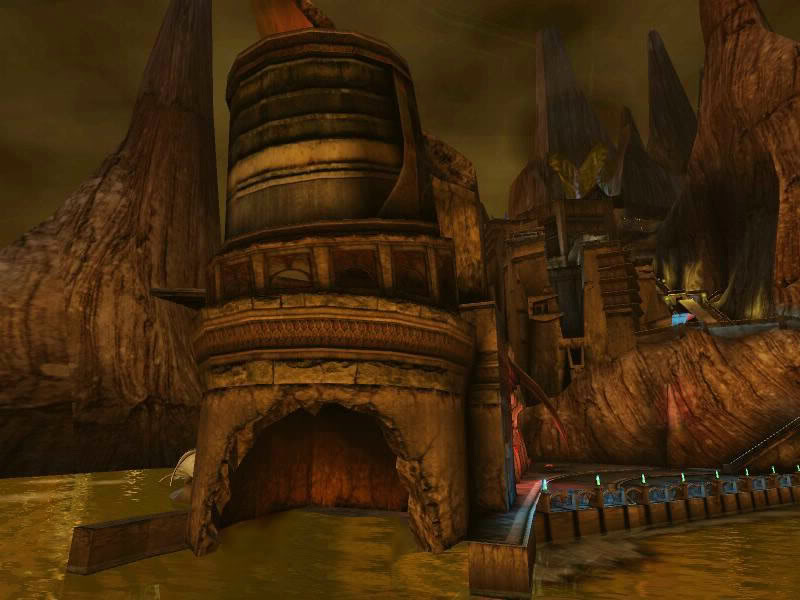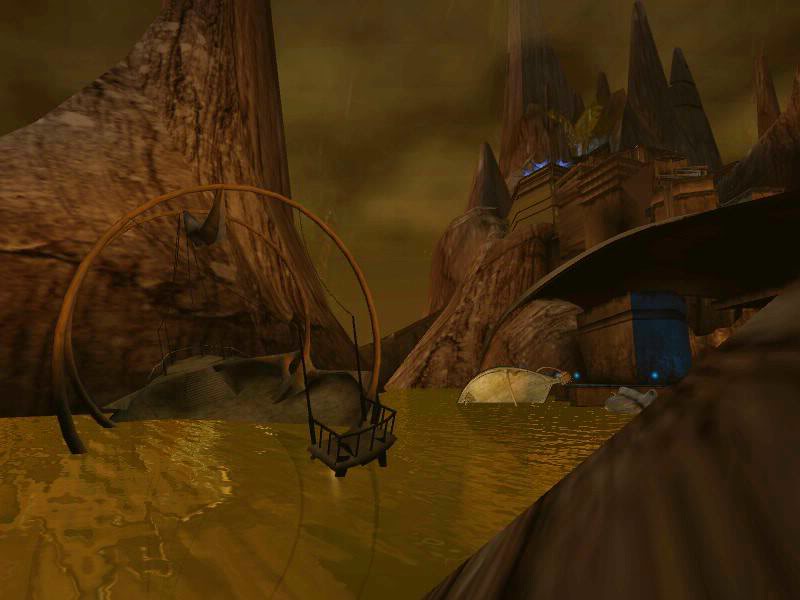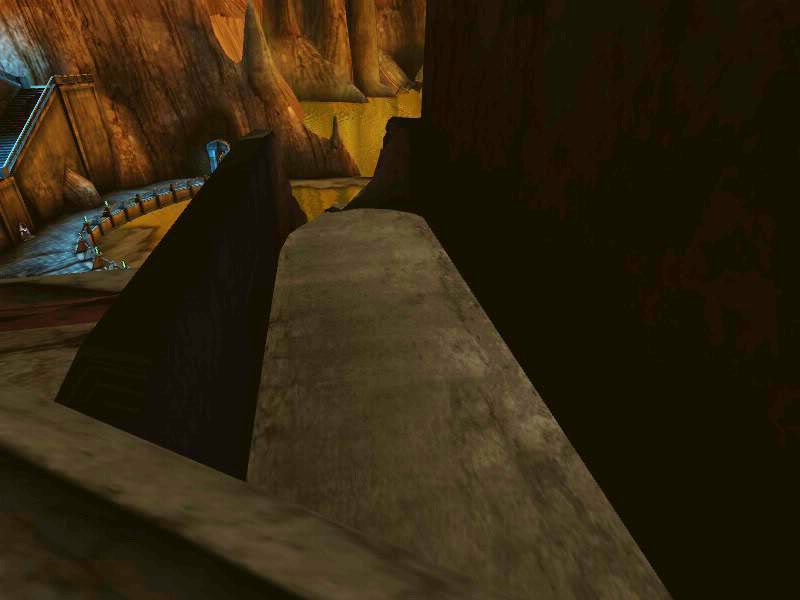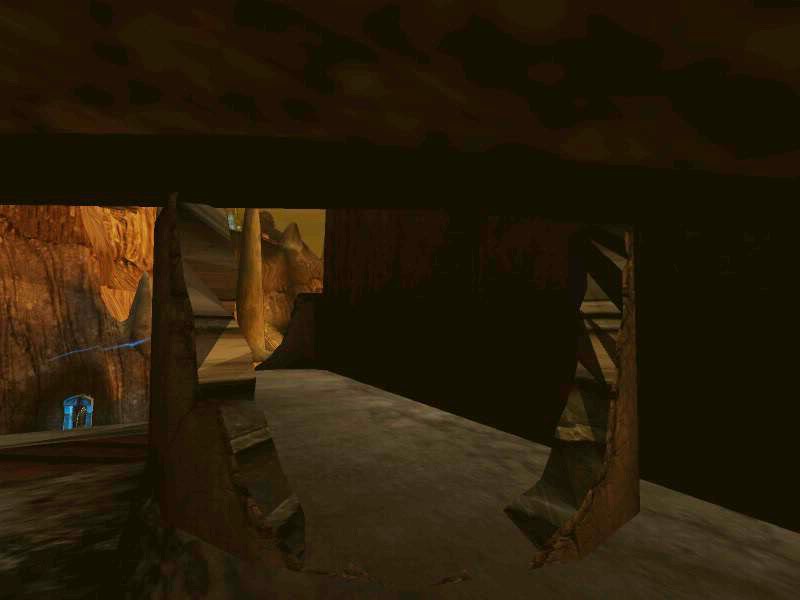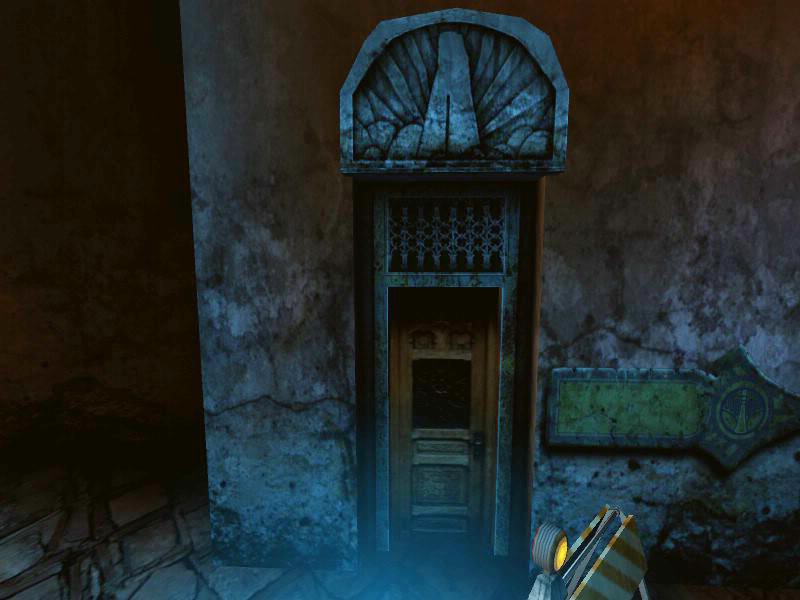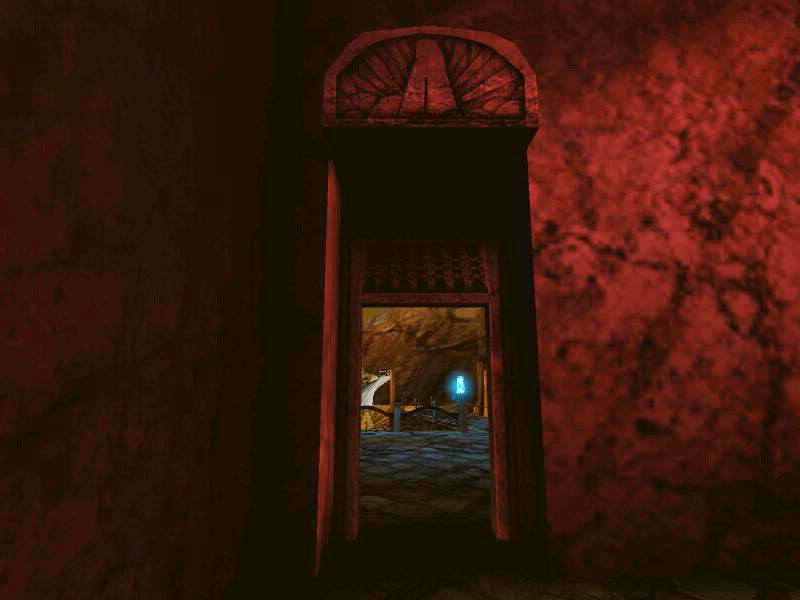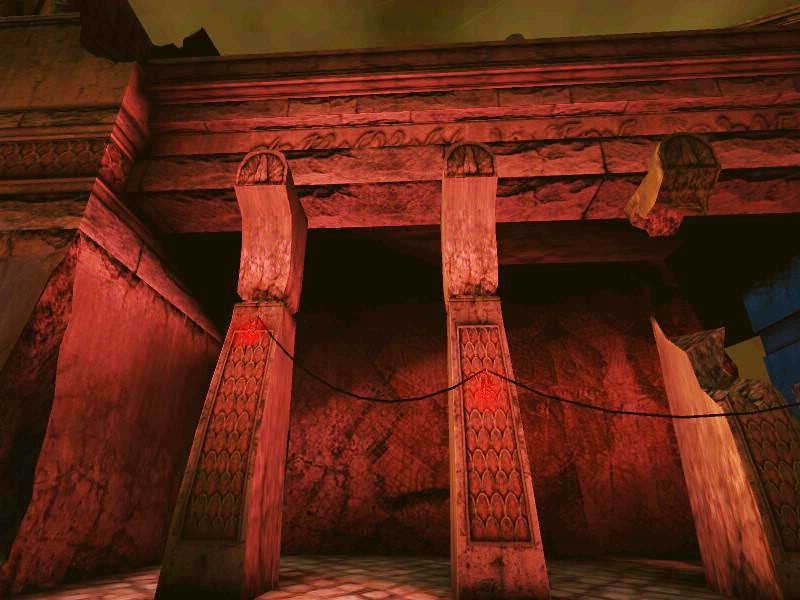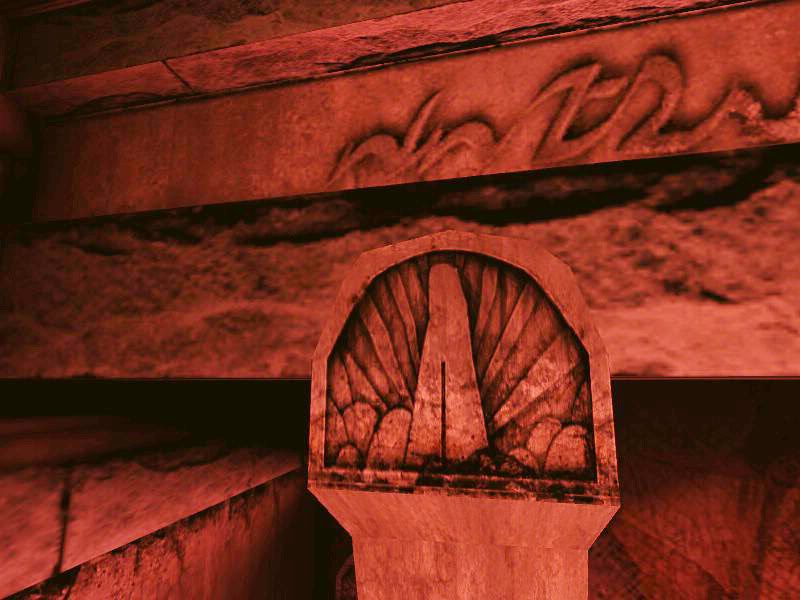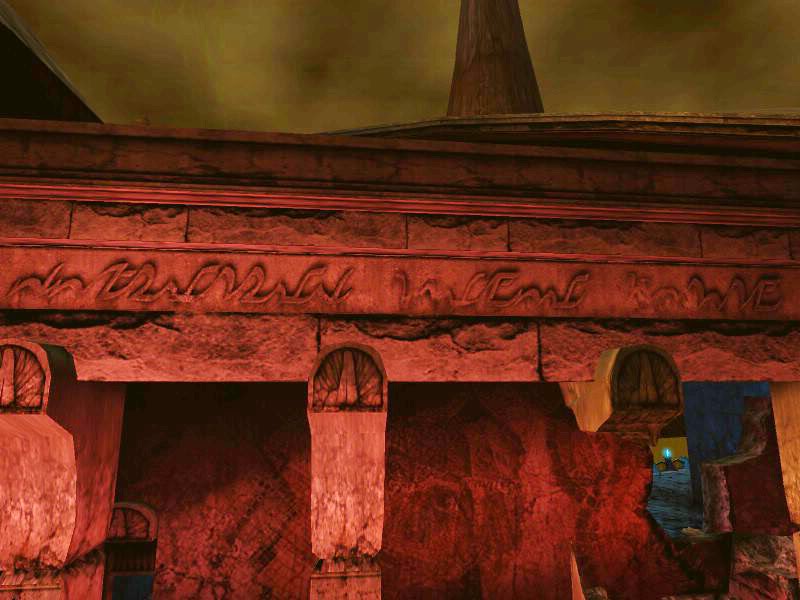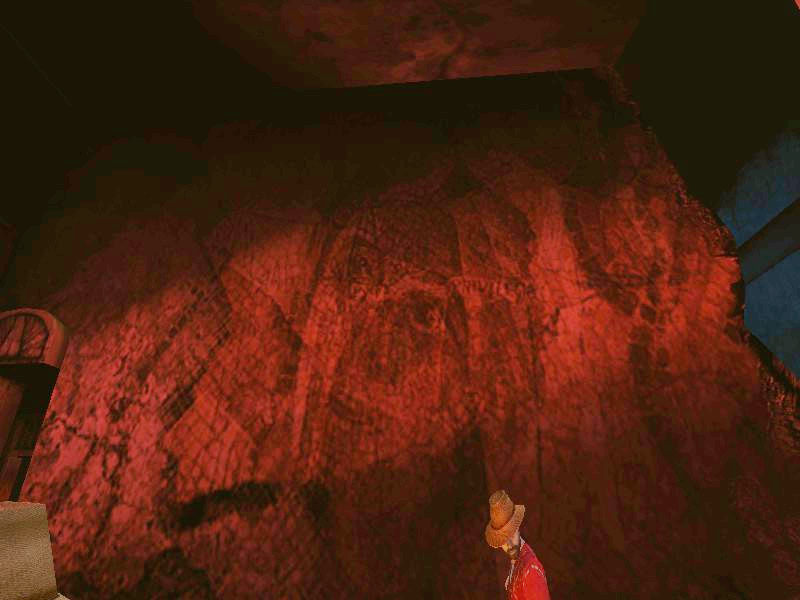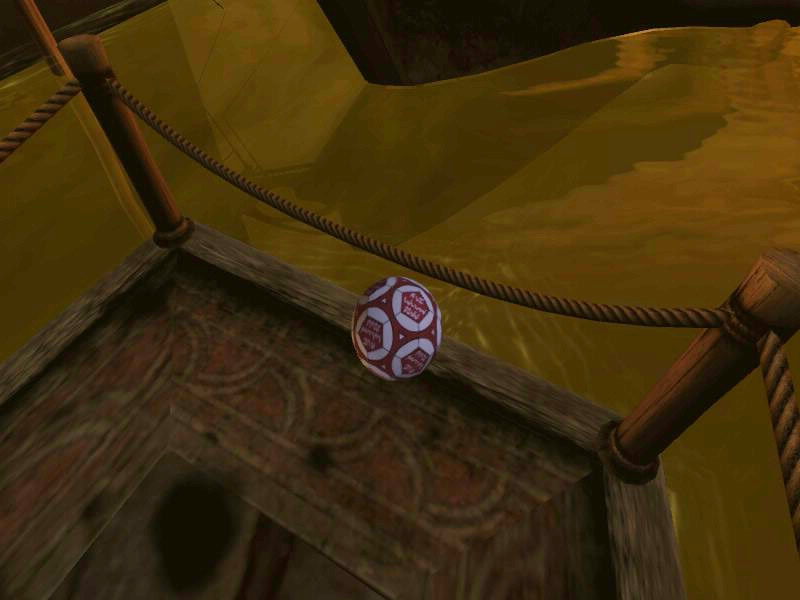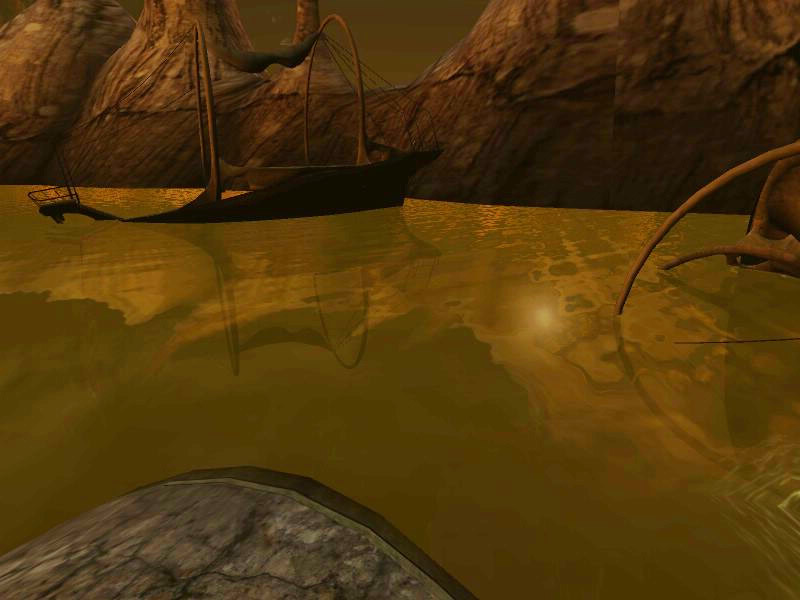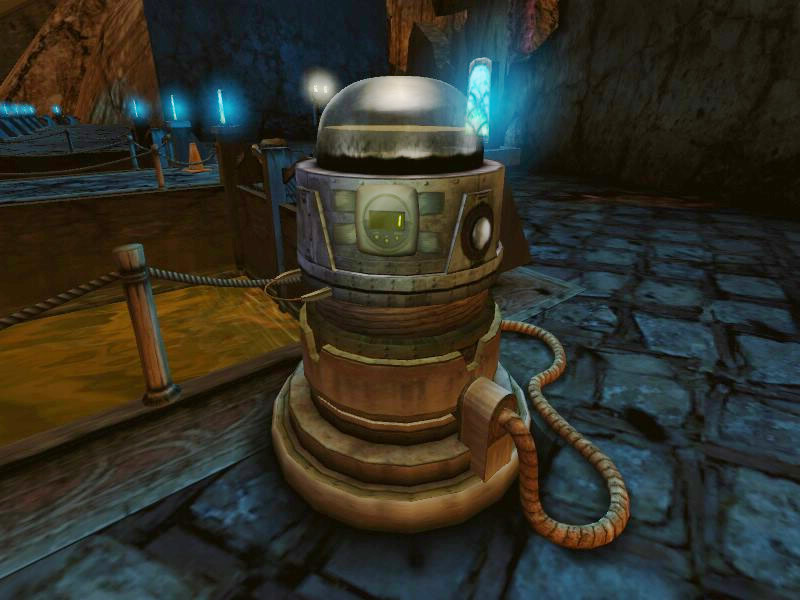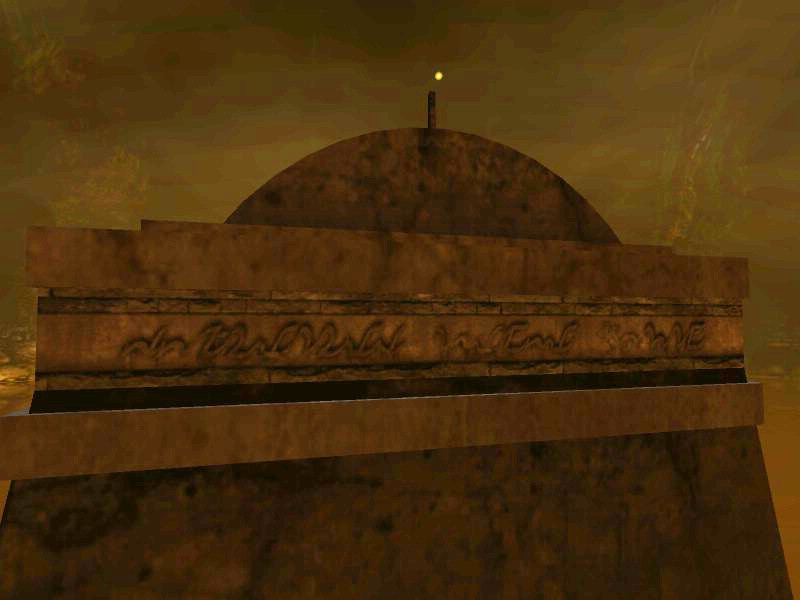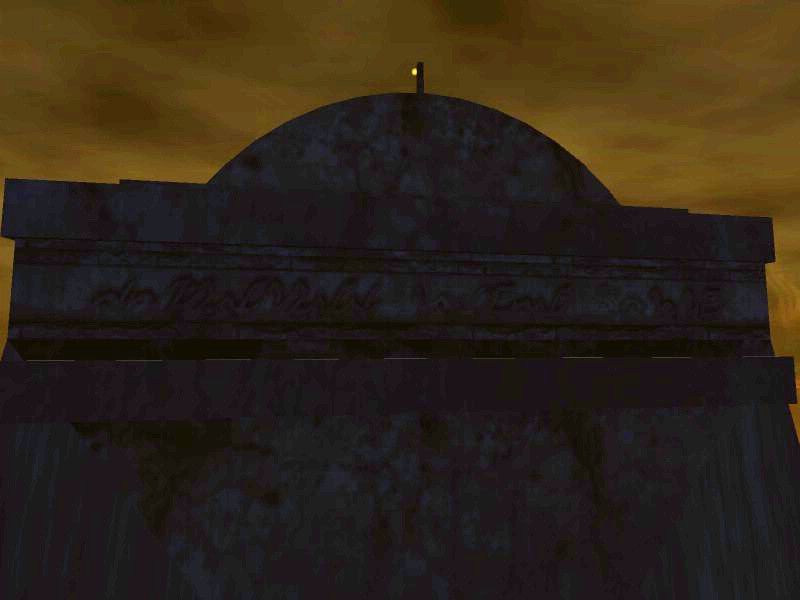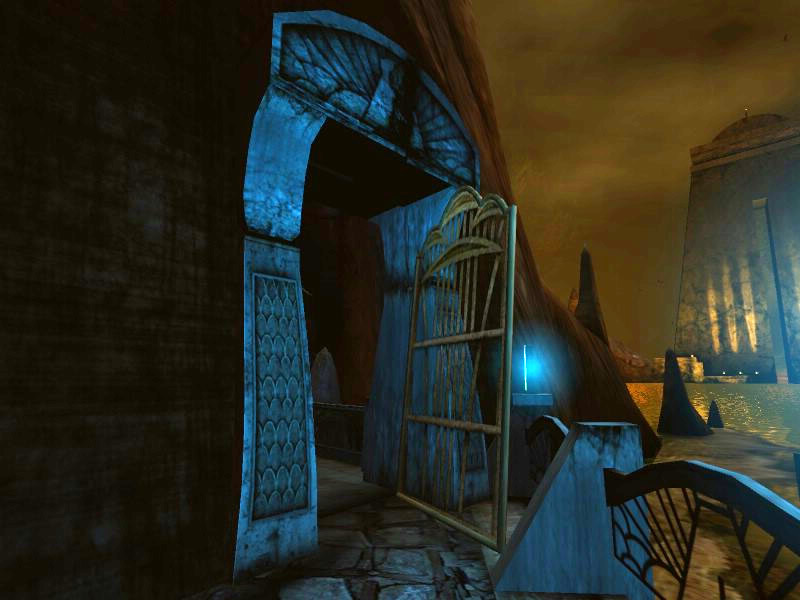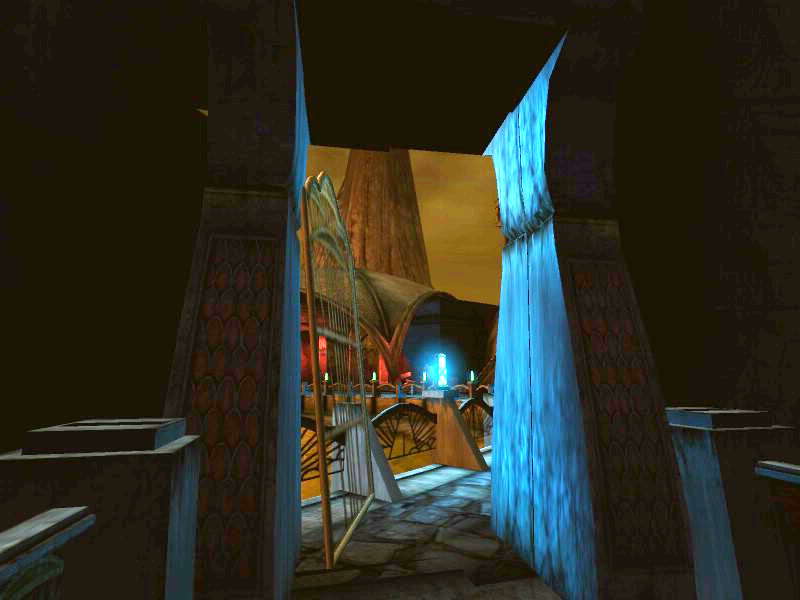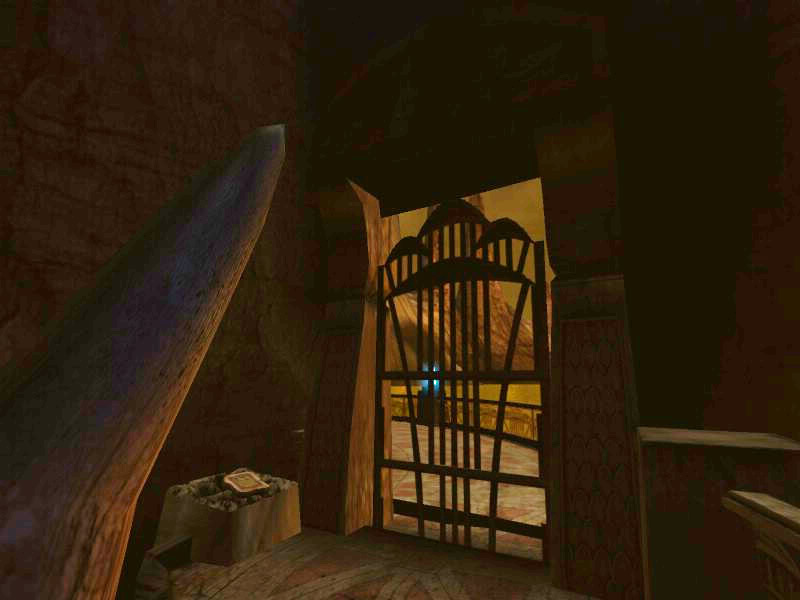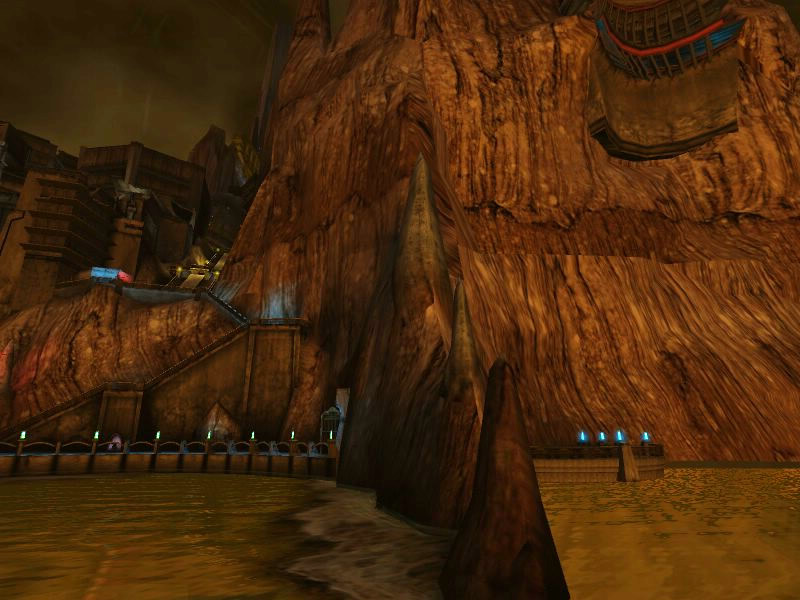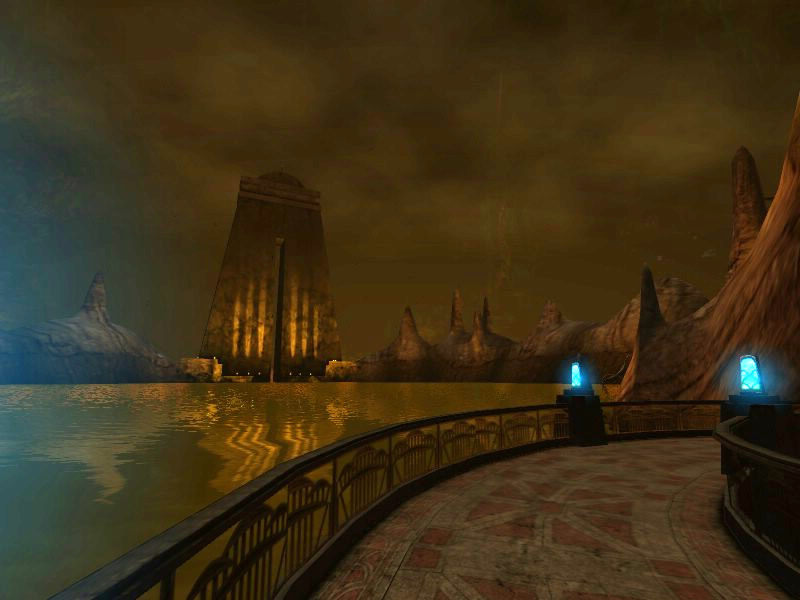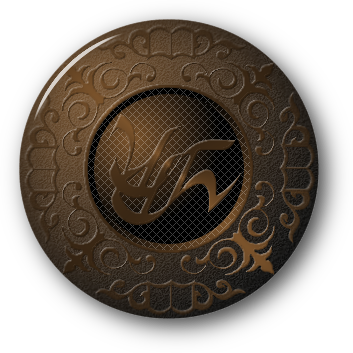

|
|
The waterfront is made up of four main sections and the harbor. The harbor is an enclosed body of water surrounded by ridges of stalagmites. The four sections are made up of the Ferry Terminal, the esplanade, a room inside a stalagmite ridge, and a short, curved walkway on the other side of the room. This picture shows the Ae'gura harbor as seen from the Concert Hall Foyer.
The only apparent exit appears to be a narrow slot in the Arch of Kerath, but that is misleading. The arch was normally used for ceremonial entrances. The primary access to the harbor was provided by a large tunnel near the Library Courtyard which is hard to see unless you are out on the water. In fact, it's impossible for one of the ferry boats to fit through the arch, which has a rather narrow opening. They are too wide for it. Here is a picture of the main entrance tunnel to the harbor. Because of the angle and it being very close to the Library Courtyard, it's very difficult to make out from land. It can be seen from the Esplanade, but shadows make it difficult to figure out what you are seeing. You can get a glimpse of it that makes it easier to figure out from the Concert Hall Foyer's overlook's right-hand end.
The Esplanade: An esplanade is a long, open, level area, usually next to a river or large body of water, where people may walk. The esplanade of Ae'gura is the level paved area next to the harbor where the Ferry Terminal Nexus pedestal can be found. At the east end is the Ferry Terminal, and at the west end is a tunnel through a naturally hollow stalagmite ridge. The tunnel opens on a short curved walkway that leads nowhere. This picture of the esplanade is a view from a boat out in the harbor.
The railings around the waterfront have two patterns in the metalwork. The first and most common is a depiction of the Arch of Kerath, a common decorative element throughout the cavern, and the second is a design representing dripstone, a type of rock formation found in caves. The latter design is found on the gates to the stalagmite, the railings inside the stalagmite, and the railings of the short walkway on the other side of the stalagmite. Here is a railing near the ferry docks that shows the typical Kerath's Arch design.
Here's the dripstone design. It's also a fairly typical pattern found on many railings throughout the caverns.
The Ferry Terminal: In D'ni year 5202, King Emen approved a new public ferry system between Ae'gura, the smaller islands such as K'veer, Katha, and Neref, and to the City Proper. The City Proper is built into the walls of the cavern, and consists of many districts, rich, poor, middle-class, and industrial. The districts include the neighborhoods explorers have been permitted to access. Ashem'en, where the Er'cana Silo is located, is one of the districts of the City Proper. Ae'gura island was primarily the center of government and religion. The peak of a mile-tall stalagmite on Ae'gura is the location of the Great Zero. The Ferry Terminal divides the Ae'gura ferry docks from the esplanade. Much of the building is a roof-covered dividing wall, with a flying roof over that, but the northern part of the building consists of a short tower that may contain a beacon, as the roof looks like it could be a lens and reflector arrangement. There is another tall building at the southern end of the dividing wall that appears blue in the picture below. There does not appear to be a door into it, which means that it was probably accessed by an underground corridor from the northern building. A question that might arise is "why would they have needed a beacon?" The answer is obvious if you know how the lake algae behaved when it was healthy and working normally. D'ni had a thirty-hour day-night cycle, and the algae gave off much more light during the cavern day than it does now. It also got quite dark during cavern night, so a lighthouse for the harbor would have been a prudent thing to have. The west side of the Ferry Terminal. Since the Nexus and KI devices were not developed until near the end of the D'ni civilization, boats were the primary means of transportation around the islands in the cavern.
The eastern side of the terminal, as seen from one of the sunken ferryboats near the docks. The flying roof over the terminal only connects to the building at its northern point; the western point is supported by the paving of the esplanade, and the eastern point either has an underwater support, or is unsupported. It's difficult to tell which.
The flying roof is made up of four sections that were connected during construction. The top of the flying roof showing the joint of the four sections:
The flying roof arches over the true roof of the terminal building, and has no supports between the two. It seems to have no other purpose than to provide a distinctive architectural element as the trademark of the building.
The flying roof from the end of the docks:
The "lens" from above:
The "lens" from the broken "reflector":
The tower and the "lens":
After the Fall of D'ni, a great deal of damage was done to the structure—and the rest of the city—by earthquakes. Several of the pillars supporting the roof of the dividing wall collapsed, and a large hole into the tower base was caused by a collapse of part of the wall. Collapsed roof and wall:
The hole in the tower:
Sunken ferry boats:
Oval room on roof with broken walls:
Another angle on the oval room:
The door into the tower may lead into a harbormasters' office, access for maintenance workers, or some other purpose entirely. However, there are large windows on the second story of the tower which provide a panoramic view of the harbor, and that points toward the harbormaster office as the most likely explanation. The door into the tower building:
Door to docks:
All along the esplanade railing, the railings around the docks, and decorating the Ferry Terminal itself are stylized images of Kerath's Arch. There is also an inscription in D'ni that reads, "rebantano tānēen shemtē". This was known as the City Slogan, but that's not what it is. In April of 2015, Richard A. Watson finally gave us the official translation, after being asked by explorer Zeke365. The canon translation is "The island welcomes you". In D'ni, it looks like this: rebantano tAnEen SemtE If we break down the sentence, it goes like this:
For decades, some rather wild guesses were made about it, since there were the words bantano and tānē were undefined, and we had no way of guessing the true meanings because this phrase appeared in several places around Ae'gura and twice in the residential neighborhoods. One proposed translation was "the [?]water refreshes you (all)", and some have even thought bantano might have meant waterfall or other related words. However, it must be emphasized that we just didn't know, and didn't even come close before RAWA finally gave us the official translation. Support pillars:
Support pillar capital:
Inscription of city slogan:
The faces on the wall: On the side of the dividing wall facing the esplanade, there are at least two areas where there is artwork of a person's head and shoulders behind the line of support pillars. I've never seen any mention of them in any DRC documents. One of the mysteries about them is that they have Roman lettering on the temple areas of the heads, which seems to spell out "PRIVILEGIA", which is Latin for "privileges". In a spectacular case of selective blindness, I never noticed the faces in my photographs or when I was crawling over the building. Thanks go to explorer Page Turner for pointing them out to me.
In the past, there was a soccer ball in the waterfront area used by the DRC and their guests to play with when they were not working. When the DRC left, it remained behind for a time, but has since disappeared, perhaps taken by one of the DRC personnel or an explorer as a souvenir.
The ball was printed with a design in D'ni characters, but the message was in "D'nenglish". It said, in effect, "D'ni Soccer Ball". The message was not written by an expert in the language, and contains some spelling errors. The characters spell out "d'nih sotstser ball" when transliterated, because the short i was used instead of the long i, and because there is no letter c in D'ni; instead, D'ni used k, and a separate character for ch. Like the beachball named Eddie in the neighborhoods, and the soccer ball named Sandy in Minkata, this ball had a nickname among explorers. Unfortunately, I can't remember it. I'm hoping that one of the visitors to this site will recall it and let me know. DRC Operations: The DRC brought in divers and engineers to determine whether or not it would be feasable to refloat one or more of the ferry boats sunk in the harbor. The survey was not completed by the time the DRC withdrew from the Cavern. Even after the DRC left, they still permitted SCUBA diving by archeologists, and the powerful lights they use when working can still be seen occasionally through the murky water.
The DRC also sponsored efforts to revitalize the lake algae using the pellet baking facility in Er'cana. For a time, they had a device to measure the level of luminescence being emitted, and placed it on the docks so that explorers could see progress. However, this backfired because it was such a huge undertaking that the meter could not show the difference. It just wasn't sensitive enough. This discouraged the pellet makers and resulted in the DRC removing the meter. The lake lighting process is still an ongoing project, although there are fewer remaining explorers contributing to it. Because of its appearance, and in keeping with the tendency of both the DRC and explorers to give nicknames to just about everything, this device was called the Dalek.
Kerath's Arch: The Arch of Kerath, which is more commonly called Kerath's Arch, was originally called the Arch of Kings. It's a massive structure at the natural opening into the harbor of Ae'gura Island, and is made of huge blocks of stone that are fitted so well you can't see the joints. The Arch was designed by Guild Master Koris in DE 558, early in the reign of King Ja'kreen. Its appearance was based on memories of a similar monument on Garternay. Construction was begun in DE 600 and completed in DE 625. According to prophecy, the Arch was to welcome the Great King when he appeared. In the hopes that they would be the one, all the kings after Ja'kreen sailed under it as part of their coronation ceremony. According to rumor, Ahlsendar was born beneath the Arch as his mother fled the Pento invasion, and so, when he passed under it again in his return to D'ni, he was thought to be the Great King. This was later disputed by his spiritual advisor after his death, since during his reign he had the Pento Plague created, which killed D'ni for generations as well as ending the Pento war by genocide. On his deathbed, King Rikooth saw his son, Kerath, sailing through the arch on a lizard-shaped boat, returning from exile. According to legend, he felt Yahvo moving him to declare Kerath the next king. Kerath, after a short reign, decided to abdicate and end the line of the monarchy, and oversaw the change of the government of to a council system. The council and Guilds renamed the Arch of Kings as the Arch of Kerath to honor him as the final King of D'ni. The esplanade faces Kerath's Arch, and there is a Nexus terminal midway along the bottom of the cliff face. The Great Stair begins here and leads up to the Tokotah Courtyard. According to D'ni history, somewhere along the edge of the harbor was the Steward's House, a location where the heir to the throne of D'ni would be crowned after he journeyed by boat under Kerath's Arch. It's possible that the House is on the bottom of the harbor now, due to the earthquakes that severely damaged the cavern during the Fall. The only decoration on the arch are carved inscriptions on the capital of the same phrase found on the Ferry Terminal. The inscriptions are on both sides of the capital. The Arch of Kerath:
The inscription on the side facing the island:
The inscription on the side facing the cavern:
The passage through the ridge: This room served as a passage between the esplanade and the curved walkway, and has security gates on both sides. The room itself has a railed walk leading directly from one gate to the other. However, the room is remarkable because it is the interior of a naturally hollow section of a stalagmite ridge, and contains stalactites and stalagmites of its own. The gates into and exiting the room are made using a dripstone design similar to the guardrails.
Just inside the entrance are two pedestals that would have once held lamps. Only the empty sockets remain.
The exit gate onto the curved walkway. The Bahro stone has a habit of appearing and disappearing, and if there is a schedule, no one has plotted it.
Here's a picture taken from a boat, showing the stalagmite ridge the room is inside.
The curved walkway: Today there is nothing to show as to what purpose this walkway was intended to serve. The only clue available is a DRC model of Ae'gura that shows a private boat marina in the area. However, the model does not show the ring of stalagmites surrounding the harbor, so there is reason to doubt its accuracy.
|
Myst, the Myst logo, and all games and books in the Myst series are registered trademarks and copyrights of Cyan Worlds, Inc. Myst Online: Uru Live is the sole property of Cyan Worlds Inc. The concepts, settings, characters, art, and situations of the Myst series of games and books are copyright Cyan Worlds, Inc. with all rights reserved. I make no claims to any such rights or to the intellectual properties of Cyan Worlds; nor do I intend to profit financially from their work. This web site is a fan work, and is meant solely for the amusement of myself and other fans of the Myst series of games and books. |
